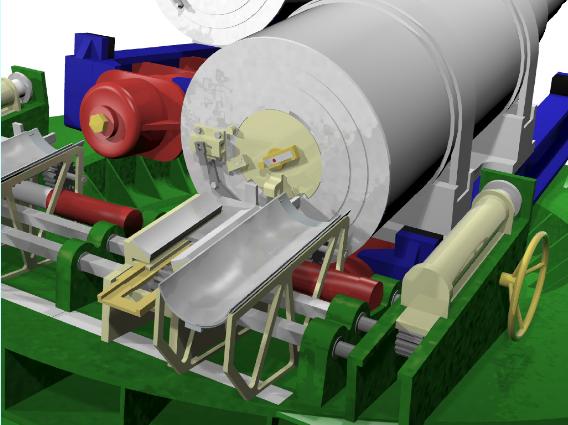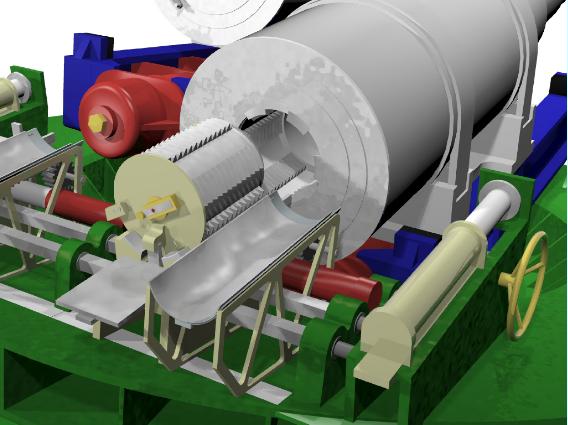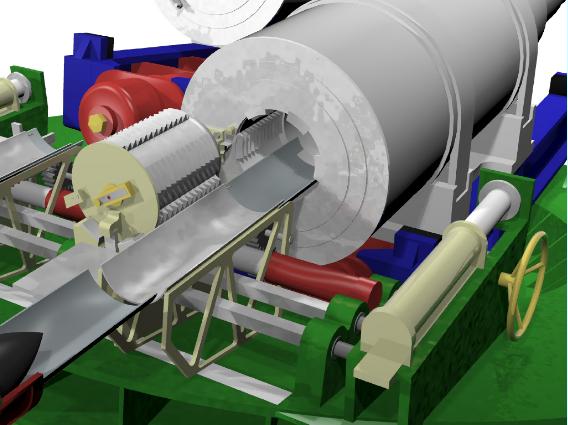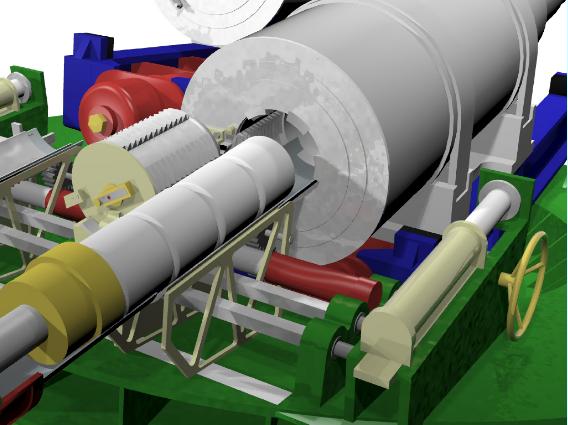| Home | Wiki | Docs | Sources | Contact |

| Loading Drill in the Turret |  |  |
 |
|||
Let's look in more detail at what is involved in that simple phrase “1 opens the breech”. The breech of a 12 inch Mk VI gun weighed nearly a ton (any detailed figures?). It was also not permanently connected to the gun itself, as later breech mechanisms would be hinged. Behind each gun was a hydraulic power saddle. This was normally in the ‘Reload’ position, as shown to the right. With the gun run in, as would be the case after firing, the front of the saddle and rear of the gun were in close proximity. To remove the breech, 1 operated a hydraulic ram which caused the saddle to shift to the right. |
|||
 |
|||||
As the saddle started to move, a lever automatically unlocked the breech, and a protrusion on the saddle pushed against a projection on the breech screw. As the saddle moved further to the right, the breech screw was rotated 30 degrees counter-clockwise. An extractor bar on the saddle mechanism then slid into a slotted lug on the breech screw when the saddle completed its rightward journey. |
|||||
 |
|||
A hydraulic ram, parallel to the bore of the gun was then actuated to remove the unlocked breech screw. As the hydraulic ram moved back, the extractor bar would drag the breech screw out of the gun and onto a support tray on the saddle. Once the breech screw was fully retracted, the saddle would be moved to the left, so that the loading tray is aligned with the bore. At the order “Place the Loading Trays” 1 rotated a handwheel at the side of the saddle to extend a tray forward and over the threads of the breech. The tray served to protect the threads from the projectile (weight 714 lbs) and the silk powder bags from the threads. |
|||
 |
|||
It was also necessary to bridge the gap between the end of the hoist and the rear of the saddle's loading tray, i.e. through the thick armour at the rear of the turret. It is not clear to me whether this was formed of a telescopic tray that extended from the rear of the saddle, or from the front of the hoist's trough, or both. In this illustration I have assumed that the extension comes from within the hoist's trough. While the breech was withdrawn from the bore, 2 reamed out the vent which passed through the axis of the breech screw, and inserted a new firing tube [details of firing tube]. Tubes were generally fired electrically, but friction tubes could be fitted in the event of an electrical failure. [Note that the firing circuit is broken until the breech screw is fully screwed into the gun. A safety switch was only switched to “On” at the command “Bring both guns to the Ready”, leaving the pistol grip firing lever disarmed until the very last moment. I would also expect the firing circuits to be broken until the gun is fully run out, but have no evidence of this so far. |
|||
 |
||||
The projectile was then rammed. The main projectiles carried by Colossus were Palliser armour piercing shell, weighing 714 lbs, common shell, or shrapnel. The powder charges were supplied in hermetically sealed cases (type W), each holding four quarter charges, in silk bags of 73.75 lbs of Prismatic Brown powder. A full (battering) charge used all four bags. Reduced charges of 2 or 3 charges reduced wear in the rifling and the cost of keeping the guns in serviceable condition. 5, 6 and 7 removed the lids from the case before placing it in the hoist's trough. Tthe rammer actually ran through the case, pushing the bags along the loading trays into the gun's chamber. With the powder loaded, the trays were withdrawn. The saddle was then moved to the right to line up the breech screw with the breech, and as the hydraulic ram moved forward, rotating drive bars and cog wheels pushed the breech screw fully home. The saddle was then moved to the right, and as it did so, the lug on the breech screw was pushed to the left, thereby screwing the breech screw back into place. Finally, with the saddle fully to the left, a catch engaged to lock the breech screw in place. [If not locked in position, the pressure built up within the gun was sufficient to push the breech screw to the rear with such force that it could turn through the 30 degrees needed to blow it out completely. This could, as they say, ‘ruin your whole day’ if you were in the turret.] |
||||
 |
||||
At the order ‘Run Out’, 1 opened hydraulic pressure to the recoil cylinder (which served to absorb the recoil momentum of the gun as it fires). The gun moved forward on its slide to the forward position. Guns were elevated by means of hydraulic rams placed beneath each gun. The turrets were trained by a pair of hydraulic training engines (for redundancy) that operated via gearing on the outside of the turret. |
||||
|
|
||||
 |  | ||
| (c) 2008 Rob Brassington, all rights reserved | |||